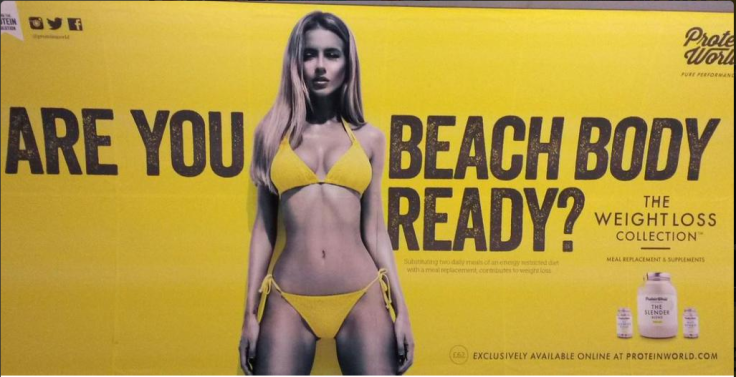Protein World's 'Are You Beach Body Ready?' Ads Travel To New York After Being Banned In London; Face Backlash

As a daily commuter on the New York City subway, I’m used to shady advertisements of provocatively dressed women asking me whether I’d consider breast augmentation, liposuction, etc. But for whatever reason, when I saw the bright yellow advertisement hanging on the wall beside my seat, I couldn’t help but stare at it for a while. It looked out of place; something about the color amid the already poorly lit subway car made it seem like this poster was trying to add an almost putrid brightness to the already dingy shades of fading orange within the car. But beyond the yellow, the woman on that advertisement, staring right at me and asking me, "Are you beach body ready?" is what really curled my skin.
She was thin, impossibly thin, wearing a yellow bikini to match the yellow background that was starting to give me a headache. I could see her ribs prominently through her skin, and her legs were so slim, I wondered if she invented the term “thigh gap.” If that’s what beach body ready is, I thought to myself, I may never see a beach again.
As I got off at the next stop, the emaciated-looking woman disappeared from my mind. Little did I know I had just seen an advertisement that spurned an international uproar.
The ad was the now infamous “Are You Beach Body Ready?” campaign launched by British nutritional supplement company, Protein World. It was first featured in the UK, and its London Tube campaign promoted a stream of backlash on social media, along with the defacement of multiple advertisements at train stations. Protein World’s seemingly taunting headline caused so much anger in body image activists and feminists alike that a petition created on Change.org received over 70,000 signatures. The petition read:
Protein World is directly targeting individuals, aiming to make them feel physically inferior to the unrealistic* body image of the bronzed model, in order to sell their product.
*for the majority of people to 'achieve': everyone has an individual body shape
Perhaps not everyone's priority is having a 'beach body' (by the way, what is that?), and making somebody feel guilty for not prioritizing it by questioning their personal choices is a step too far. A body's function is far more intricate and important than looking 'beach ready,' so in fact it is Protein World who have confused their priorities, if anyone.
Public protests and pictures trended throughout blogs and Twitter accounts of real women, looking “beach body ready,” by being comfortable in the body they have. The hashtags #EverybodysReady and #EachBodysReady also spread through Twitter as women showed off their beach bods in every shape and form.
Are you beach body ready? Anything like me & that statement gets you riled.. http://t.co/UjoPKN9zdt #eachbodysready pic.twitter.com/UsgGNvPXCr
— Amy Treasure (@MrandMrsTplus3) June 23, 2015just the white ones, apparently “@NiamhAWalsh: Yes! Taking back the tube one poster at a time. #EachBodysReady pic.twitter.com/BtmlqB9I5U”
— Jonathan Frandzone (@NotAllBhas) April 30, 2015.YES @DoveUK this is what we're talking about #EachBodysReady pic.twitter.com/JU2U8pL9Yg
— Imogen Mead (@MimoMead) April 30, 2015The advertisement caused such a stir that it launched an investigation by the Advertising Standards Authority (ASA), an independent advertising “watch dog” organization that subsequently had the ad banned. When asked for its reasoning behind the ban, the ASA told People, “Due to our concerns about a range of health and weight loss claims made in the ad, it can’t appear again its current form.”
Perhaps even worse than the advertisement itself was the way Protein World responded to the ad, unabashedly backing its misogyny. In an interview with Sky News, Richard Staveley, the marketing chief said that model Renee Somerfield was what their customers wanted to see, an “aspirational” female figure of fitness perfection. He also said that the backlash against the campaign was “fantastic,” claiming that the negative press was now giving Protein World more publicity than it ever had before.
Arjun Seth, the company’s chief executive went so far as to call those protesting the ad “terrorists,” claiming their form of feminism was nothing more than extremism.
Unfortunately, Staveley was not wrong when it comes down to Protein World’s sales. According to Business Insider, even though the ad was slated to be removed on April 29, lasting no more than 3 weeks on the London Tube, the outpouring of negative response resulted in a boost in direct sales revenue amounting to about $1.5 million dollars.
“It’s a big middle finger to everybody who bothered to sign that stupid petition in the UK,” said Staveley “You could say that the London protesters helped pay for the New York campaign.”
Staveley also told Breitbart London that, in addition to a massive advertisement in Time Square, the bright yellow reminder of your inadequacy will be posted at “every New York subway entrance” in eight-second digital spots.
Where Do You Stand On The @ProteinWorld Debate? http://t.co/cYF9T9kjje #eachbodysready #feminism pic.twitter.com/F94bjjatDc
— ANNA'S FRIENDS (@ANNASFRIENDS) April 28, 2015But the increasing advertisements have already started causing a stir in New York, as the poster in Union Square subway station has already been vandalized, along with other subway advertisements. Many UK activists who contributed to the ban on the advertisement are currently waiting expectantly to see what New York will do next.
Change is in motion
From the dawn of advertisements, women have been depicted unrealistically in order to make consumers feel self-conscious, and subsequently buy the product to “improve” themselves. This is how advertising works, “it preys on the vulnerable,” Dr. Ramani Durvasula, a clinical psychologist and professor of psychology, told Medical Daily. “They perpetuate the idea of ‘I’m not good enough,’ which can impact eating behaviors and exercise behaviors, and ultimately lead to anxiety, depression, and full blown eating disorders.”
Durvasula also stated that images like Protein World’s are especially damaging, because they portray a view of health and fitness that is far from the truth. “The idea that healthy looks a certain way, that you can see healthy on the outside is not true because 99 percent of what constitutes healthy can’t be seen on the outside. It’s a mental state, it’s on the inside. This cannot be observed by looking at someone’s body and it certainly cannot be done by ingesting one product.”
So how do we respond? Many women in NYC have turned to protest. In fact, the Huffington Post reports that feminist groups, the National Women’s Liberation, and Redstockings have recreated the 1969 “This Oppresses Women” sticker, and is distributing the sticker throughout NYC subways to advertisements that negatively portray the female body.
"Women are sick of being bombarded with advertisements that depict women only as sexual objects," Erin Mahoney of National Women's Liberation told HuffPo. "That use of our bodies to sell products. That embolden men to disrespect us. That tell us we are not worthy unless we conform to unrealistic, sexist, racist, and unhealthy beauty standards. Women are fighting back and using [the 'This Oppresses Women'] vintage sticker to do it. It's exciting."
It’s all about education
While protesting is effective in starting a discussion about why advertisements like this are detrimental to body image, fighting can only get us so far. “I do think there has to be pushback, but there also has to be a knowledgeable way to consume [these images] because we are not going to get rid of them," Durvasula said.
On the tube this morning. Well done graffiti. Too right. #eachbodysready pic.twitter.com/mS2ygCX7aI
- Samuel Valentine (@MrSamValentine) April 30, 2015Living in a day and age where we are bombarded with images put in place by a capitalist economy that controls how and what we consume, it is difficult to put pressure on such an intricate system and get it to completely revoke its ways. But that doesn’t mean there isn’t hope; in fact there is still an answer, and that answer is media literacy.
“When you start protesting it, they’re going to make more [money]. Stop trying to fight them from the front, and try to stab them in the back,” said Durvasula. “Even if it means a grassroots effort where every mother explains to their daughter what that image means.”
According to Durvasula, media literacy entails changing the way we consume images, especially within advertisements, to sharpen awareness that these images do not represent a wider population, but are instead manipulating us via our inherent vulnerabilities. “It involves showing imagery and challenging people to think, ‘What are they really doing here? What does this represent?’ Look at the depictions of people of various weights, and teach kids at a young age that there is a larger truth than what is going on here.”
Consuming images differently is key, especially when taught from a young age, so that young girls and adolescents, those most susceptible to the false messages the media portrays, will know their story does not have to reflect a skinny yellow woman in a bikini.
“This requires the parents to be literate about the images they are seeing; if the parents, the teachers, and the health care providers don’t know what’s going on, then kids won’t,” Durvasula said. “[Media literacy] needs to be built into school curriculums, college curriculums, and [taught by] health care providers. There are going to be yellow bikini images out there more and more, but we need to teach them what they mean. It’s about starting young.”
While it’s a sad reality that images like this still exist, and are likely not going anywhere anytime soon, that doesn’t mean we need to subscribe to them. By showing young girls and women that their body is beautiful, even if it’s not represented within advertising, we can stop the detrimental effects of media on mental health, and really hit Protein World where it hurts.



























